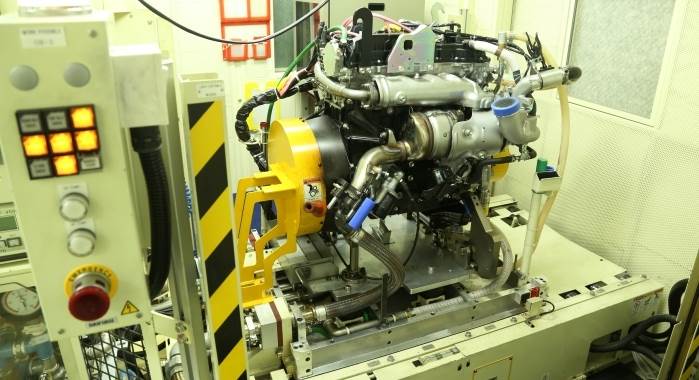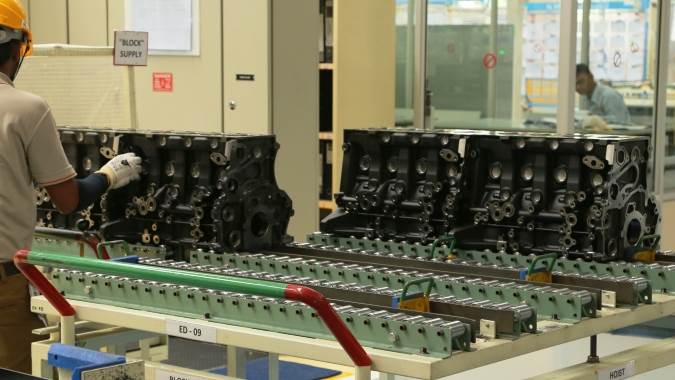'Looking at the Indian market, there is a strong possibility of making lower-capacity diesel engines but nothing is decided yet.'
T R Parasuraman, deputy managing director, Toyota Industries Engine India on the company's future investments, transiting to BS-VI emission norms and Toyota's roadmap for diesel versus petrol in India.
T R Parasuraman, deputy managing director, Toyota Industries Engine India talks to Shobha Mathur about the company's future investments, transiting to BS-VI emission norms and Toyota's roadmap for diesel versus petrol in India.
With the recent shift in the market towards petrol engines, do you think diesel is fast losing its attractiveness in India?
I feel diesel is still quite attractive in the Indian market due to three reasons — one, it leverages a clean technology that is ramping up year on year; the CAFÉ regulations, especially in 2017, will be even more stringent. Hence to maintain the Corporate Average Fuel Efficiency, all companies should have a stable of both petrol and diesel (models) which is very important. And, finally, from the mileage point of view, diesel is more fuel efficient.
We will also get cleaner fuels and the government of India is also upgrading in line with the new policies. So a mix of both petrol and diesel engines will dominate the market but from 60-65 percent in favour of diesel a couple of years ago, the diesel portfolio has now dipped to 40-45 percent due to recent challenges. However, I am sure diesel will always be attractive for the Indian market. It is only a question of time before diesel picks up.
What is the roadmap for diesel versus petrol engines for Toyota in India?
We have a petrol assembly facility at Bidadi in Bangalore where the 1.5- and 1.2-litre petrol engines for the Toyota Etios and Liva are made. The InnovaCrysta and Fortuner have diesel engines while the Corolla is powered by both petrol and diesel motors. So we are largely diesel.
Will smaller displacements or still higher-capacity diesel engines also be developed at the plant in the long term?
Looking at the Indian market, there is a strong possibility of lower capacity diesel engines but nothing is decided yet. Probably Toyota Industries Motor Corporation, our parent company, will work very closely with Toyota Kirloskar Motor and if there is a possibility explore that. But, at this point, there is no concrete plan.
Obviously, the Indian car market is small car-centric. So definitely it is the small cars that are very important as well as MPVs where Toyota has a strong presence. The small car is also very strategic for Toyota, so if there is a possibility then the small car is a strong potential for our diesel engines.

Toyota Industries Engine India has a production capacity of 108,000 engines per annum and currently produces around 8,000 a month for the Innova Crysta.
Currently, the 1.4-litre diesel engine is imported from Japan for the Toyota Etios and the Liva but yes, it would be better to make it here. However, setting up an operation for it would be very capital intensive. Hence, market stability is very important. A lot of uncertainty has prevailed recently, so our parent company will formally study the current situation and probably discuss closely with customers if there is the necessity and then take a call.
Also, a lot of factors are involved in arriving at this decision as capacities in other plants have to be considered as well. When Toyota has a global exposure, it will leverage the capacities in other plants and it may not be logical in terms of economics and scale to invest in such a plant.
How much more investments do you foresee in the future expansion of the diesel engine manufacturing facility?
The current capacity has involved an investment of Rs 1,100 crore. Further investments will depend on what parts we plan to make in-house and what will be sourced. We are looking aggressively at the next level of localisation.
But definitely for further expansion, lesser capacity will be involved so there will be lower investments. For instance, for small car engines, probably an investment of around Rs 600-700 crore can be a ballpark figure. Funding comes mainly from our parent.
How equipped is TIEI for transiting to BS-VI emission norms by 2020? What modifications will have to be made in the current crop of engines to be ready for it?
At present the engines are compatible with BS-IV emission regulations and we can upgrade to BS-V and BS-VI norms since in Japan we are already manufacturing the same diesel engines to meet BS-V and BS-VI emission standards.
So we have the technology in place; for moving to BS-V we may have to add the diesel particulate filter and some more parts that go into the assembly line. Once we move to Euro 6, we may have to adopt specific selective catalytic reduction technologies. All these technologies are with Toyota and it is a question of adjusting our assembly lines and some final assembly adjustment at the customer’s end.
However, we have sufficient lead time and we should be able to ramp up as quickly as possible as the technology is very easy to adapt. We will have to train our people for its use and they will be sent to Japan for the purpose. Several engineers may also come from Japan to train our people here. We have currently not started but it is easy to cross-pollinate.

The TIEI plant also makes large and small transmission parts that it supplies to sister concern Toyota Kirloskar Auto Parts. Images: Sudhakar Thippanakaje
Continuous engineering has gone into the Toyota engines and all accuracies and fuel efficiencies have been improved at the design stage with a lot of focus riveted on weight reduction and control of emissions through newer technologies.
The diesel engine that we make at Bidadi is the same global diesel engine as in Thailand and Japan, but in Japan, it is Euro 5 and 6-compliant while in Thailand it ranges from Euro 4 to 6. The engine here delivers an improved power and mileage of 15.2kpl compared to the engine that powered the earlier Innova.
How do you view the growth in the diesel engine market in India going forward?
Our Indian plant is part of our global operations and India has been growing in leaps and bounds and has been a very diesel-centric market historically.
Toyota’s Thailand diesel engine plant has been catering to Thailand and some Asia-Pacific requirements while Japan largely meets the need of its domestic market. So Toyota is looking at India as one of the future growth-centric operations and also for using the Indian supply chain that exists here.
India has very talented engineers, HR is very attractive, and the supply chain is very competitive. It is time that we foster and develop them. India is a captive market and growth is seen on the cards. So it is a strategic decision to set up a diesel engine plant in India at this time.
What type of training did the staff here undergo?
About 80-90 engineers were sent to Japan for training and when they returned they trained others in India. The Japanese trainers also came and trained group leaders and supervisors, who in turn trained the workers according to Toyota work culture. It was a three-year journey involving a lot of training and human development.
Training includes knowledge of systems, daily management working in addition to hardcore technical training on how to identify problems on the line and troubleshoot. The diesel engines in Thailand and Japan cater to similar vehicles as in India.
Which are the new technologies that are trending in diesel engines and what are the challenges?
Technologies are becoming fantastic in diesel and are being upgraded to meet the evolving emission standards. The concept that diesel is polluting is completely fading out and noise, vibration and harshness are no more differentiators for engines due to the refinement in the technology.
Thailand also has a large diesel market though, in Japan, still large cars like the Landcruiser Prado are diesel cars since the market is quite big. But Thailand is more diesel compared to Japan which is more petrol.
How has the TIEI diesel engine been lightweighted?
Lightweighting has been undertaken from the design perspective and across many parameters. Use of an efficient combustion technology with a lot of thermodynamics have maximised fuel efficiency in terms of fuel burning and lower emissions. A lot of work has gone into it.
With its production, we have achieved the Make in India vision and for most components that are low-hanging fruit the local supply chain has been established.
In Phase II next year, the team will work at increasing localisation of other parts. We should look at beyond 50 percent indigenisation. The first step was to achieve a stable quality, then sustainable delivery and performance and then utilise the local supply chain and step up localisation.
Do you have a local R&D capability as well?
Going forward, local R&D will be very important for the Indian market but our parent will have a strategy for India. At present, the R&D functions are centralised in Japan.
How has the diesel ban on above 2000cc engines in the Delhi-NCR impacted TKM sales?
We have been hit by both the sales of the Innova and the Fortuner and overall 7-10 percent of total sales have been impacted. We provide clean diesel engines based on the global platforms, so the logic is not very clear. But we are hopeful that the government will revisit the issue.
RELATED ARTICLES
Setrans Mobility Booster Charging top-up 25% EV range in 15 minutes
Two enterprising tech-savvy entrepreneurs Rana Roshan Singh and Vivek Ummat of Noida, Uttar Pradesh-based start-up Setra...
'Our products are proudly 100% designed and made in India'
Creatara Mobility, a New Delhi based electric two-wheeler startup, claims to have tackled various challenges in making i...
'EVs have been around for a much smaller time than ICE, so best practices are still evolving'
EV OEMs and start-ups are under pressure to reduce production costs and bring them close to ICE counterparts. Vaibhav Ku...





 By Shobha Mathur
By Shobha Mathur
 14 Aug 2016
14 Aug 2016
 9239 Views
9239 Views









